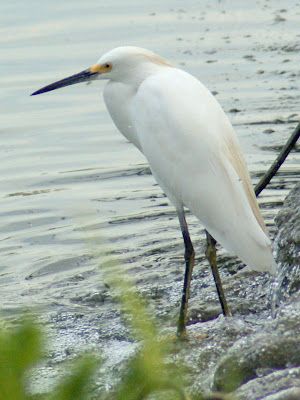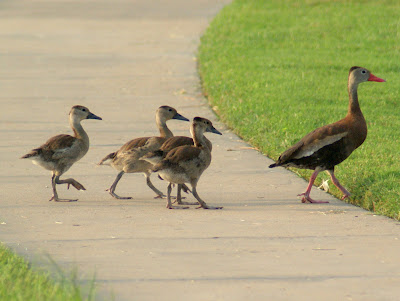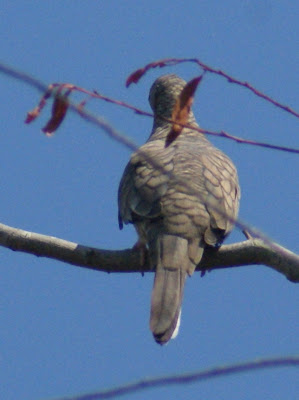.One of the great things about living in southeast Texas is that you don't have to go birding to see birds. You can see them in your yard, on your commute, at your work, in the mall parking lot - just about anywhere, in fact.
I was reminded of this the other day when I had to take my wife to a local medical center. While she was with the doctor, I took a walk around an ornamental pond behind the medical building. As I expected, many of the birds at the pond were exotic ducks. However, there were also some other birds.
First up was a Eurasian Collared Dove.
Nearby a Snowy Egret was fishing.
A male Great-tailed Grackle was showing off.
And a female Grackle was looking interested.
A family of Black-bellied Whistling Ducks crossed the path ahead of me on their way to the water.
Several other families of Whistling Ducks were already enjoying the pond.
An hour later, on my drive to work, I had a good look at a Scissor-tailed Flycatcher enjoying its lunch.
.
Jeff Mohamed blogs about birds and other wildlife in the Houston area - and occasionally farther afield.
Friday, September 30, 2011
Wednesday, September 28, 2011
Tuesday, September 27, 2011
Sheldon Lake
.
When I visited Colorado and Montana last month, I was bowled over by the beauty of the mountain scenery in Rocky Mountain and Glacier National Parks. I was constantly asking myself why on earth I live in flat-as-a-pancake southeast Texas.
However, after getting back to Houston, it took only a brief visit to Sheldon Lake Environmental Center to remind me why I like southeast Texas. It's because the whole area is just bursting with life - plant life, bird life, insect life, reptile life ...
Let me show you what I mean by giving a quick photo report on just some of the wildlife I saw in 90 minutes at Sheldon.
New Feature
I was impressed to see that Sheldon Lake now has a fantastic new observation tower, which even has an elevator!
From the top you get great views of the lake.
In a few months the tower should also make it possible to get good views of the large flock of Snow Geese that usually winters on the site.
.
When I visited Colorado and Montana last month, I was bowled over by the beauty of the mountain scenery in Rocky Mountain and Glacier National Parks. I was constantly asking myself why on earth I live in flat-as-a-pancake southeast Texas.
However, after getting back to Houston, it took only a brief visit to Sheldon Lake Environmental Center to remind me why I like southeast Texas. It's because the whole area is just bursting with life - plant life, bird life, insect life, reptile life ...
Let me show you what I mean by giving a quick photo report on just some of the wildlife I saw in 90 minutes at Sheldon.
New Feature
I was impressed to see that Sheldon Lake now has a fantastic new observation tower, which even has an elevator!
From the top you get great views of the lake.
In a few months the tower should also make it possible to get good views of the large flock of Snow Geese that usually winters on the site.
.
Saturday, September 24, 2011
Good Friday
.Friday was a good day at CyFair.
The mesquite trees betwen the Library and the Technology Building had a Wilson's Warbler.
However, this time they also had a Common Yellowthroat, a bird that I've never managed to get a good photo of.
A Great-tailed Grackle was bathing in the artificial river.
He did not look pleased to see me.
The nature trail was quiet for migrants, except for a male American Redstart and an Eastern Wood-Pewee (below).
However, I did get a brief glimpse of an Inca Dove, a bird that I don't think I've ever seen before at the college.
Near the start of the trail, I was surprised to see what looked like a 9" or 10" black worm thrashing about in the undergrowth. When I got closer, I realized it was a very large and very agitated cottonmouth.
It's easy to see how this snake gets its name.
I don't know what had made the snake so upset. It can't have been me, because its tail was thrashing about when I was still yards away. Also, even with me standing very close by, the snake soon calmed down and closed its mouth.
So, a Common Yellowthroat and a Cottonmouth. That certainly made Friday a good day.
.
The mesquite trees betwen the Library and the Technology Building had a Wilson's Warbler.
However, this time they also had a Common Yellowthroat, a bird that I've never managed to get a good photo of.
A Great-tailed Grackle was bathing in the artificial river.
He did not look pleased to see me.
The nature trail was quiet for migrants, except for a male American Redstart and an Eastern Wood-Pewee (below).
However, I did get a brief glimpse of an Inca Dove, a bird that I don't think I've ever seen before at the college.
Near the start of the trail, I was surprised to see what looked like a 9" or 10" black worm thrashing about in the undergrowth. When I got closer, I realized it was a very large and very agitated cottonmouth.
It's easy to see how this snake gets its name.
I don't know what had made the snake so upset. It can't have been me, because its tail was thrashing about when I was still yards away. Also, even with me standing very close by, the snake soon calmed down and closed its mouth.
So, a Common Yellowthroat and a Cottonmouth. That certainly made Friday a good day.
.
Thursday, September 22, 2011
Vultures
.Driving along Porter Road End yesterday, I came across a bunch of Turkey and Black Vultures picking the flesh off what looked like the skeleton of a cow. Most of the Vultures flew off when I stopped but a couple of brave Black Vultures stayed where they were.
It's easy to distinguish between our two Vulture species. Black Vultures have gray/black heads and necks and their plumage is black except for white wing tips.
Turkey Vultures, which are significantly larger, have red faces and they have white feathers all along the trailing edge of their wings.
The two species have very different flying styles, too. Once they are in the air, Turkey Vultures rarely flap their wings. They don't need to, because they are incredibly good gliders. Black Vultures are less good at gliding and they have to flap their wings frequently to stay aloft or to gain altitude. So if you see a Vulture in flight and it's flapping its wings, you can be pretty sure that it's a Black Vulture.
.
It's easy to distinguish between our two Vulture species. Black Vultures have gray/black heads and necks and their plumage is black except for white wing tips.
Turkey Vultures, which are significantly larger, have red faces and they have white feathers all along the trailing edge of their wings.
The two species have very different flying styles, too. Once they are in the air, Turkey Vultures rarely flap their wings. They don't need to, because they are incredibly good gliders. Black Vultures are less good at gliding and they have to flap their wings frequently to stay aloft or to gain altitude. So if you see a Vulture in flight and it's flapping its wings, you can be pretty sure that it's a Black Vulture.
.
Tuesday, September 20, 2011
Quite a Change
.After months of heat and drought, this weekend was quite a change. This was brought home to me on Sunday afternoon, when I dropped in at Russ Pitman Park to see if any migrants were around. Within a couple of minutes I had spotted a Blue-gray Gnatcatcher, a Black-and-white Warbler and a Great Crested Flycatcher.
Unfortunately, I had no sooner photographed the Flycatcher than the heavens opened and I had to run from the rain.
On Monday morning I took a walk along the nature trail on the CyFair campus. I was hoping that the weekend's storms would have blown in some migrants. At first all I saw were common residents, such as Northern Mockingbirds and Mourning Doves.
To be honest, though, I was pleased to see Mourning Doves yesterday and to have seen dozens of them on the campus over the past weeks. A few months ago I was starting to worry that our numerous White-winged Doves had driven away their smaller and less aggressive cousins.
I was just about to leave when migrants began arriving, starting with a male Baltimore Oriole.
A Great Crested Flycatcher was nearby, its rusty red tail making ID easy.
Then I was thrilled to see a Prairie Warbler, a bird I've only seen twice before and that we've never seen on the campus.
.
Unfortunately, I had no sooner photographed the Flycatcher than the heavens opened and I had to run from the rain.
On Monday morning I took a walk along the nature trail on the CyFair campus. I was hoping that the weekend's storms would have blown in some migrants. At first all I saw were common residents, such as Northern Mockingbirds and Mourning Doves.
To be honest, though, I was pleased to see Mourning Doves yesterday and to have seen dozens of them on the campus over the past weeks. A few months ago I was starting to worry that our numerous White-winged Doves had driven away their smaller and less aggressive cousins.
I was just about to leave when migrants began arriving, starting with a male Baltimore Oriole.
A Great Crested Flycatcher was nearby, its rusty red tail making ID easy.
Then I was thrilled to see a Prairie Warbler, a bird I've only seen twice before and that we've never seen on the campus.
.
Subscribe to:
Posts (Atom)



















































